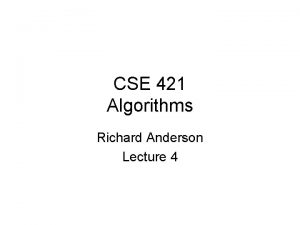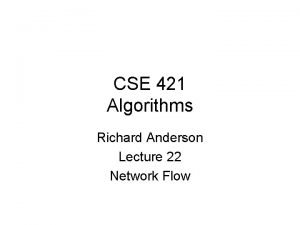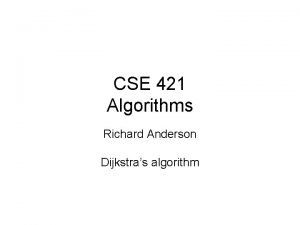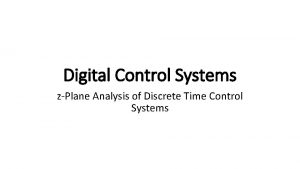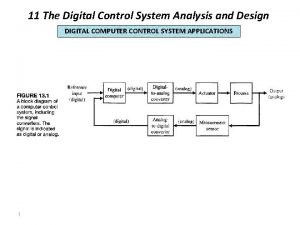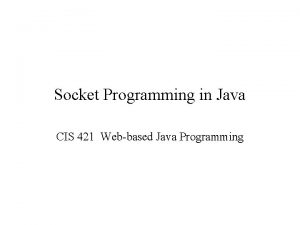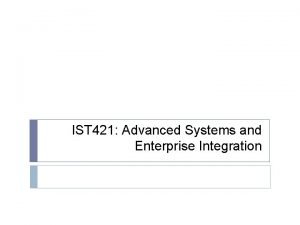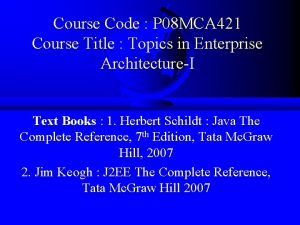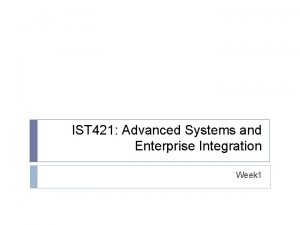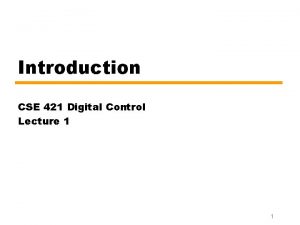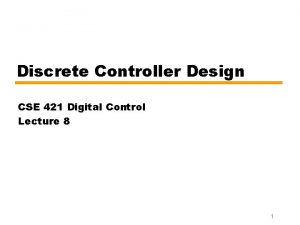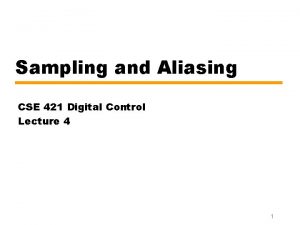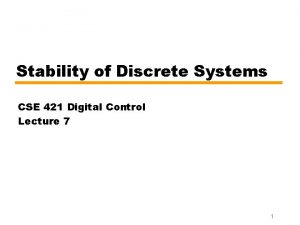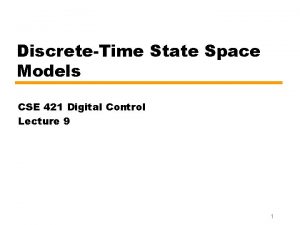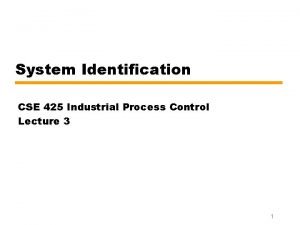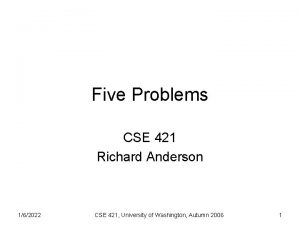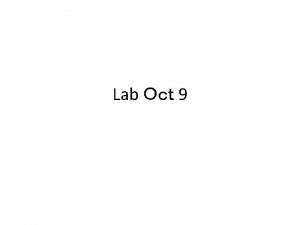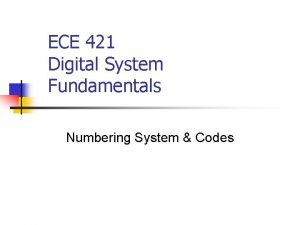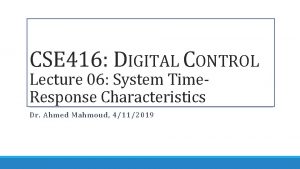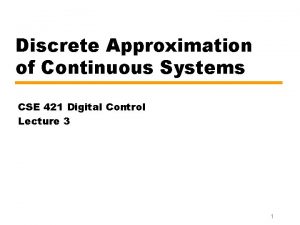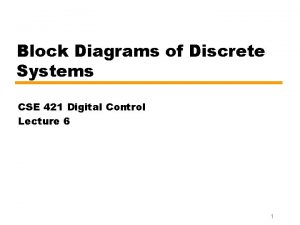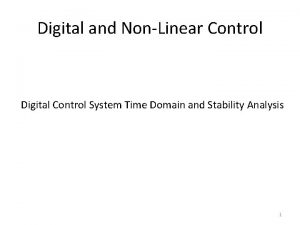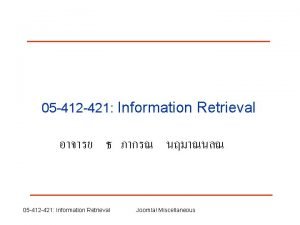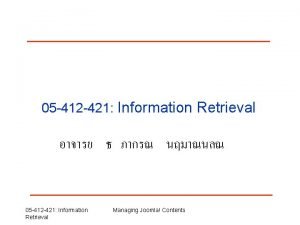System Identification CSE 421 Digital Control Lecture 12






















- Slides: 22

System Identification CSE 421 Digital Control Lecture 12 1

Introduction • In order to be able to design a controller for a dynamic system, we must have a model of the system describing its dynamic behavior. • In principle, there are two approaches to finding the model: physical modeling and system identification. • Physical modeling is analytical approach in which basic principles (laws of motion, electrical laws, …) are used to obtains di�erential equations describing system behavior. • While this is useful in gaining insight into system behavior, actual physical phenomena may be too complex to permit satisfactory description using physical principles. 2

System identification • When physical modeling is not feasible, we may resort to the experimental approach called system identification. • In this approach, we first excite the plant with some input sequence, u(0), u(1), …, u(N), and record the corresponding output response, y(0), y(1), …, y(N). Then, we construct a model from this observed data. • In these slides, a brief introduction to system identification using the least squares method is presented. 3

Worked example • Consider the following first-order model: — There are two unknown parameters a and b. • The model can be rewritten as a difference equation: — A feed-forward term u(k) was not included because it is virtually never seen in a physical system (unlike a controller). 4

• Using the input-output sequences, we can write the following equations: • These are N equations in 2 unknown a and b. • As the number of equations > number of unknowns, there is no value for a and b to satisfy exactly all equations (this is called an over-determined system of equations). 5

• To deal with this issue, let us insert additional term ε(i) in each equation to account for noise and modeling error. • This set of equations can be written in matrix form: 6

Finding the parameters a and b • What we are looking for is a value for θ (i. e. a and b) which makes the best compromise between all the equations, i. e. try to minimize the equation errors ε(1), ε(2), …, ε(N). • One possibility is to choose a and b that make the sum of all errors minimum. That is, to minimize: • However, this is not a good choice. Why? 7

• To penalize both positive and negative errors ε(i), we seek θ that makes the sum of squared errors minimum. That is, • This leads to the well-known least-squares problem. • This cost function is differentiable and a global minimum for which can be achieved when the model is linear-in-the-parameters. 8

• Note that: • Hence, the least squares problem can be written as 9

• Noting that: • the cost function can be written as • In order to minimize εTε, we need to find the following derivative and equate it to zero: • Note that εTε is scalar while θ is a vector (of size 2 x 1 in our example). How to differentiate a scalar function with respect to a vector? 10

The gradient • The derivative of a scalar function f with respect to a vector θ is called the gradient and is defined as 11

The gradient: rule 1 • Consider a scalar function f of two parameters a, b: • The gradient of f with respect to θ is written as: 12

The gradient: rule 2 • Now, consider a quadratic function f in a and b: • The gradient of f w. r. t. θ is the following vector: • So, we can write the following rule: 13

• Using these rules, we return back to the original least squares problem: Where: • Setting the gradient to zero gives • Which finally gives the least squares estimate: 14

Example 1 Consider the following model where u(k), y(k), and ε(k) are, respectively, the input, output, and the equation error at time instant k. Given the following input output data: q deduce the regression matrix Φ q calculate the least squares estimate of a and b. q calculate the model output q calculate the residuals t u (t ) y (t ) 1 2 3 4 5 1 2 4 5 7 1 3 5 7 8 15

Answer • We can write: 16

• Hence, the least squares estimate is given as: 17

• Using the estimate of a and b, the model output is given by • Hence the residuals are 18

Example 2 Consider the following model where y(k) is the system output at instant k and e(k) is an equation error. Given the following input output data, q deduce the regression matrix Φ q calculate the least squares estimate of a and b. q calculate the model output q calculate the residuals t u (t ) y (t ) 1 2 3 4 5 1 2 4 5 7 1 3 5 7 8 19

Answer • We can write: 20

• Hence, the least squares estimate is: • Using the estimate of a and b, the model output is • Hence the residuals are 21

Model order selection • The choice of model order (i. e. the number of parameters) is up to the designer. • The designer may perform multiple fits with di�erent orders and select the lowest order fit that yields acceptable agreement. • Selecting a model of too-high order means that you use the “extra” parameters to fit noise in the data. 22
 Cse 421
Cse 421 Cse 421
Cse 421 Reverse delete algorithm
Reverse delete algorithm Central pocket vs plain whorl
Central pocket vs plain whorl 01:640:244 lecture notes - lecture 15: plat, idah, farad
01:640:244 lecture notes - lecture 15: plat, idah, farad Zero order hold laplace
Zero order hold laplace Digital control systems examples
Digital control systems examples Digital control system analysis and design
Digital control system analysis and design Introduction to digital control system
Introduction to digital control system S domain
S domain 421 could not create socket
421 could not create socket Cs 421 programming languages and compilers
Cs 421 programming languages and compilers Pediatric fluids 4 2 1
Pediatric fluids 4 2 1 Ist 421
Ist 421 Here is where your presentation begins
Here is where your presentation begins 4 2 1 rule
4 2 1 rule 421 rule
421 rule 4 2 1 fluid rule
4 2 1 fluid rule Fwm 421
Fwm 421 Fwm 421
Fwm 421 Business process integration tools
Business process integration tools Uiuc cs 421
Uiuc cs 421 Ist 421
Ist 421
